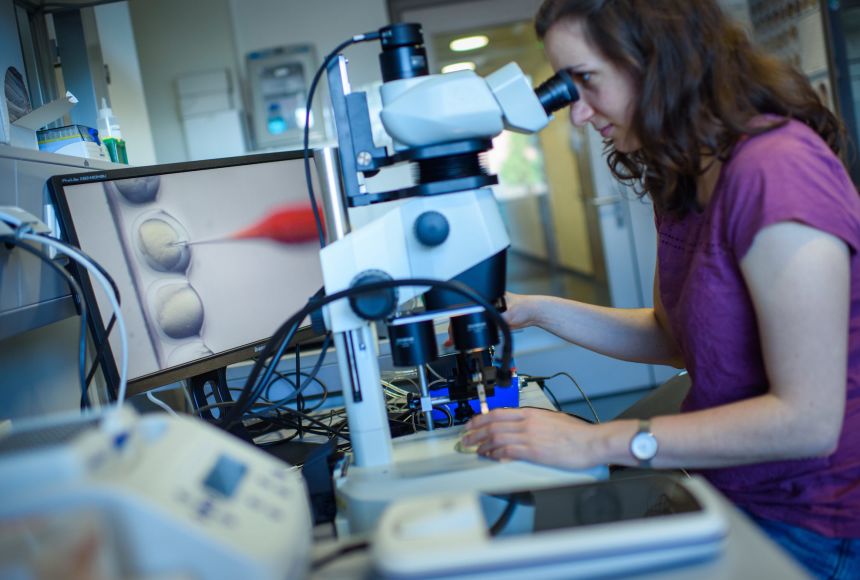Genetic engineering is not new—the capability to manipulate human DNA, and the associated ethical concerns, have been around since the 1970s. However, within the past five years, an effective and affordable new tool for precise gene editing, called CRISPR, has fanned the fires of hope, curiosity, and controversy for both scientists and the public, bringing discussions about genetic engineering back into the spotlight.
CRISPR stands for Clustered Regularly Interspaced Short Palindromic Repeats. It is a naturally occurring genetic feature of bacteria used to fight invading viruses. Adapted by scientists for laboratory use as a molecular biology tool, CRISPR has greatly reduced the time and cost associated with gene editing in a broad range of organisms. CRISPR gives researchers the ability to more easily add, remove, or change regions of an organism’s DNA, which has potential applications for agriculture and for the study and treatment of disease.
CRISPR was discovered by scientists in Spain in 1993, but its function and capabilities were not understood for another ten years. It was not until 2013 that the first results demonstrating its use for mammalian gene editing were published. With that landmark paper, however, interest from the research community and the private sector exploded. CRISPR is now transforming how scientists perform experiments with gene splicing and how they envision the future of CRISPR for potential medical and agricultural applications.
Similar to some other gene editing tools, CRISPR works like a pair of molecular scissors. It cuts DNA at specific locations and either deletes sections or replaces them with alternate sequences. CRISPR involves two key biochemical pieces: first, a short stretch of RNA—a molecule similar to DNA—that binds to the target DNA sequence, acting as a guide for the CRISPR system, and second, an enzyme (a type of protein) that does the cutting. The RNA sequence is fairly simple to synthesize in the lab. This makes the CRISPR process easier than some of the older gene editing systems that require the complex bioengineering of desired molecules. The most common enzyme used in CRISPR is called Cas9, though there are other enzymes that work in nature and are also used in the lab. But because Cas9 is the most commonly used enzyme, the whole gene editing system is sometimes referred to as CRISPR-Cas9.
Media sources abound with stories about the possible use of CRISPR for human gene editing. Most current work, however, is in fundamental laboratory science—studying cells and animal models whose genes have been altered using CRISPR. Such studies of genetically altered animals, using myriad techniques and tools, have been done for decades to model human health and disease. This field of research provides important information about how certain genes influence the human body’s function and well-being. It can be particularly powerful in studying disorders that are linked to the malfunction of genes.
Examples of such research using CRISPR include studies of cell cultures and animal models that have led to the correction of genetic flaws in human patients with cystic fibrosis and Duchenne muscular dystrophy. If these results are reproduced and proven safe, it is possible that one day this type of gene editing could be used routinely to treat those, and other, diseases. Much more work is needed to evaluate how often CRISPR may be cutting nontargeted regions of DNA. Unwanted changes in DNA sequences could introduce harmful mutations that outweigh possible beneficial medical outcomes. Nonetheless, the first human clinical trials using CRISPR are underway.
In other biomedical studies, CRISPR is being used to modify the DNA of pigs. The goal of that research is to remove certain viral susceptibilities that are impeding the use of animal organs for transplants in human patients. The number of human organs donated and transplanted each year meets only a small fraction of the growing need for transplants. Obtaining organs from animals is one possible solution to the organ shortage problem, and pigs are currently the favored animal for this area of research.
Outside of basic and clinical research, CRISPR has also made an impact in plant science and ecology. The use of CRISPR in agriculture is already becoming widespread, for many of the reasons genetically modified foods have historically been developed. Genetic modification can make crops more resistant to pests, lessening the need for use of environmentally harmful chemical pesticides. It can also make crops stay fresh longer, allowing them to be shipped long distances without spoilage. CRISPR could thus help to ease the global food-shortage crisis, providing fruits and vegetables to remote areas of the world.
Additionally, there may be opportunities to use gene editing to help keep endangered species from becoming extinct. It might also help remove invasive species from particular regions. Ecologists are exploring these possibilities.
Despite the potential role of CRISPR in addressing medical and environmental challenges, there has been great controversy and well-founded concern over its broad use. Modifications to human body cells may be able to treat diseases, but modifications to germ cells—egg and sperm—would affect not only the recipient of the gene therapy but also their offspring. This fact alone raises concerns about potential long-term dangers of CRISPR.
Furthermore, as with older methods of genetic engineering, CRISPR offers the possibility of modifying human embryos to create “designer babies,” children who have been genetically designed according to the tastes of the parents. This possibility has led many countries to ban the editing of both germline cells and embryos. Biomedical breakthroughs—especially ones involving the altering of human genes—often give rise to heated debates about how to ethically regulate the new tools without unduly hindering their progress. The same can be said for CRISPR, and its rapid adoption in many scientific fields will certainly inspire further discussion about both its promise and potential hazards. Even so, scientists hope this revolutionary advance will provide great benefits in medicine, agriculture, and other fields.
